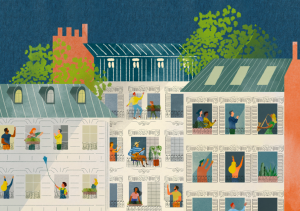Our last post in the series ended with two questions for providers: “How can we best care for you?” and “How are you caring for yourself?” Inspired by these questions, this post discusses the difference between self-care and community care, and why understanding this difference is key to the long term survival of the early childhood system.

Activism to decrease the stigma surrounding mental illness and growing awareness of how toxic stress builds up in the body have made “self-care” a hot button topic. A glance at Google search term analytics shows that, starting around the beginning of 2016, the phrase took off in popularity, peaking in April 2020. Google trends also considers the phrase “self-care plan” as a breakout term, meaning the phrase had a “tremendous increase” in searches compared to little to no searches a few years ago.
Many researchers and early childhood advocates are focused on the mental health impacts of the pandemic for young children, as the first three years of life are so crucial to development. As a field, however, we must pay equal attention to providers. Trauma begets trauma, and child care providers cannot pour from an empty cup.
Research shows that the pandemic is changing our brain function. When the body is under the constant stress of trying to keep ourselves and others safe, the prefrontal cortex, the part of our brain responsible for complex decision making, shuts down. Cortisol, the stress hormone, is released in the body to activate both our learned and instinctual responses to threats. When we are stuck in this activated state for long periods of time, it diminishes our ability to think abstractly, to empathize and to complete tasks like planning, paperwork, writing and organization.
Paradoxically, all of these activities are even more necessary as the school year begins, as some providers reopen, others adapt to virtual learning and their school age children returning, and providers try to mitigate added risk as children move between various environments where they may be exposed to the virus.

Care providers and the people who in turn care for them are also impacted by “compassion fatigue.” You may have heard of the compassion fatigue phenomenon as it applies to supporting a grieving loved one. Often times, a bereaved person receives care and attention from their community shortly following the traumatic event, but support drops off over time. This means that as the pandemic continues, providers will struggle to provide the same quality of supportive interactions with young children, and also struggle to receive the support they deserve.
Indeed, as the adrenaline of the early pandemic fades and exhaustion sets in, child care providers need more support, not less. This, and the hindrance to brain function caused by unprecedented stress, can make self-care practices such as mindfulness, journaling or establishing routine more difficult to practice.
Thus, calls to prioritize “self-care,” though very important, can sometimes invalidate people who are struggling to care for themselves and need community to step in. Community care acknowledges the interdependence of us all – a lesson more and more of us have remembered again when it comes to child care in the pandemic. The nervous system is soothed by the co-regulation that occurs in community, which in turn helps each individual to self-regulate.
So, what would a robust system of community care look like? We often hear about talk therapy as a first line response to mental health crisis. Yet, a large percentage of providers have no health insurance, so therapy is not affordable. Peer support specialists, often serving in local health departments, may be a promising option to meet increased need. Peer support specialists also have personal experience recovering from mental illness or addiction, and are therefore able to provide horizontal, rather than the top-down support other mental health professionals provide, which can sometimes feel impersonal.
For family child care providers, FCC networks also provide connections with peers, can help centralize or provide systems for completing paperwork and offer services like training and technical assistance. Many counties have child care directors meetings with Child Care Resource and Referral staff as additional support. Currently, special initiatives like the North Carolina Hope4Healers Helpline (1-919-226-2002) are connecting frontline workers to licensed mental health professionals. Advocating for increased funding for resources of this kind is one way to practice community care.

Of course, community care also means fighting against the injustices that keep providers struggling for survival, rather than thriving. A thriving workforce is one with access to fair wages, comprehensive benefits, quality working conditions and freedom from racial and gender-based violence and discrimination.
Are you a child care provider? How can the community show up for you as we move into the school year? Write to us here.




